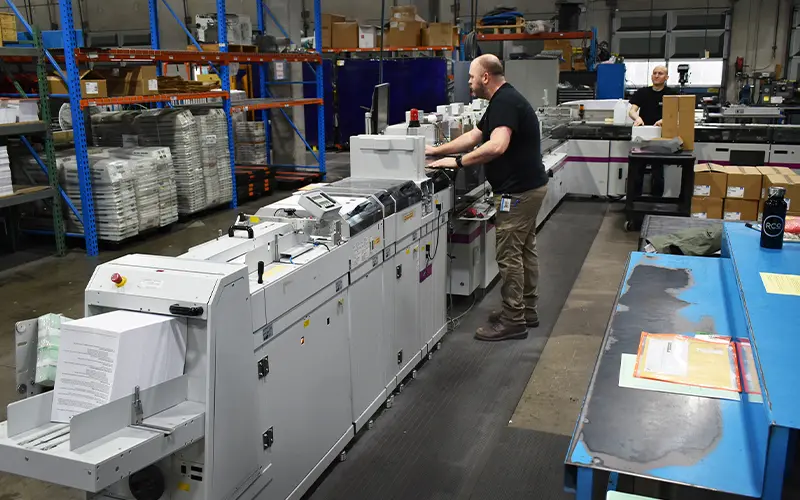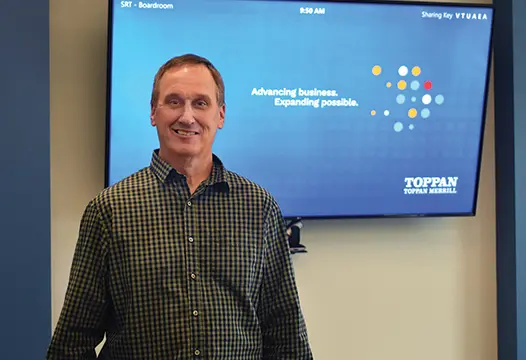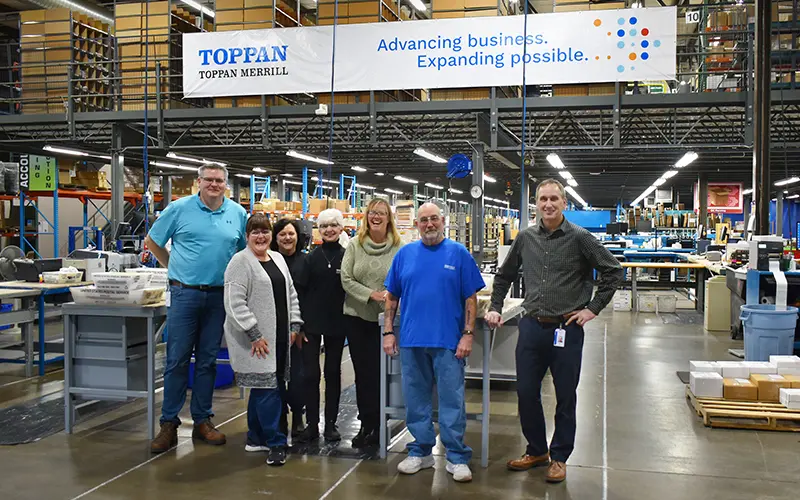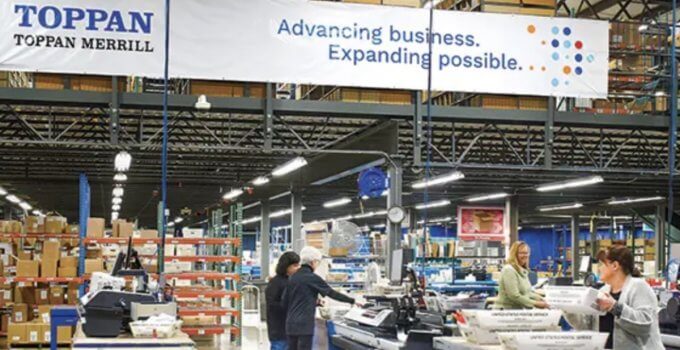In a large, blue building in a quiet part of central Minnesota, big things are happening at the Toppan Merrill operations facility in Sartell.
Toppan Merrill supports companies with regulatory disclosure and regulated communications requirements. That means if a company needs to provide government or legally mandated communications, Toppan Merrill brings more than 55-plus years of regulated communications expertise and decades of printing operations experience to the table to help companies stay compliant.
What are regulated communications? These required communications vary from company quarterly and annual reports and shareholder communications to personalized onboarding packets for health care plans.
In an era in which printing on physical paper is becoming less common and less necessary, over the last five years Toppan Merrill has invested heavily in digital printing technology, has consolidated facilities, and has expanded operations to meet its clients’ needs.

Take big steps to support a complex industry
In 2019, Toppan Merrill merged its St. Cloud and Sartell facilities, moving equipment and teams about 20 minutes north along the Mississippi River to Sartell.
“The industries we support demand flexibility, and digital printing is variable and can be personalized,” says Mike Zimny, Toppan Merrill’s senior vice president of operations. He says the company has expanded its Sartell facility and expects to invest $7 million in new technology by mid-2023.
Toppan Merrill is headquartered in St. Paul and has more than 2,000 global employees, more than 200 finance and accounting professionals, and boasts it completes 1.2 million global regulatory filings, and 62,000 annual SEC filings. The company is part of the world’s largest printing company Toppan Holdings, a Hong-Kong-based company that employs 54,000-plus people worldwide.
Toppan combined its own investment with the aid of tax increment financing to expand its facility to 200,000 square feet and build a team of more than 275 employees who work three shifts. New Canon toner and ink jet digital printers, the latest pick-pack technology, and the newest personalized mailing technologies are now in place.
The sensitive and often tightly regulated nature of the documents printed and handled requires a notable level of security, including background checks for employees and scanned name-badge entry into the facility. Employees undergo annual training on fraud, waste, abuse, and security. Cameras placed strategically throughout the facility monitor nearly everything. A more typical printing facility producing materials outside of federally regulated industries would not have these security infrastructure requirements.
Strategic moves
COVID-19 hit America as Toppan Merrill was wrapping up the Sartell expansion and presented a strategic challenge. A large portion of the materials the company produced were designed as marketing materials to accompany face-to-face meetings, trade shows, and seminars. As COVID temporarily shuttered many of those events, it also reduced demand for the marketing-minded products Toppan Merrill would print for them.
That, Zimny explains, prompted Toppan Merrill leaders to consider how they might shift their business. They decided to focus on the regulated, mandated — and more complicated — print materials.

“Marketing materials are still a part of our business, but the pandemic really shifted how businesses communicated with customers,” Zimny says. Today, Toppan Merrill focuses on regulated, mandated activities, which require smaller, on-demand printing runs that are more personalized. Clients seek reduced costs through print-on-demand distribution that reduces physical spoilage and storage costs and enables them to generate only products and pages most relevant for their needs.
The ‘right’ print is valuable
It’s clear that Toppan Merrill is doing a lot of things right. The investment in technology and consolidating facilities and streamlining processes has yielded a 56% increase in the number of color pages produced since 2021, a figure company managers expect to grow even more as clients move to an on-demand model.
“They’re so much more efficient,” says Dawn Loberg, an Enterprise Minnesota business growth consultant.
Toppan Merrill also continues to invest in technology that enables clients to make online changes, monitor the production process, and audit the mailing outcome of pieces for regulatory requirements as well as efficiency. A skilled service team supports clients through each important regulatory filing step for SEC required financial filings, while service and project teams support the daily needs of customers with regulated and required printed business communications.
“Providing service support through technology is not only modernizing the customer experience, it’s also expanding the breadth of how we deliver support to our customers,” Zimny says.
Company culture
The average tenure for an employee in Sartell is 15 years. One reason is Toppan Merrill’s longstanding commitment to area communities.
“We believe it is important to celebrate diversity and to give back to our communities in a way that is meaningful to each of our employees,” says Shelly Taylor, Toppan Merrill’s senior human resources business partner in Sartell. In addition to on-site activities to support employee engagement, she says, the company provides a paid Community and Diversity Involvement Day that enables employees to take a paid day off to support a favorite cause or organization.
Sartell employees this year have supported local food shelves, the annual school supply drive, and the winter drive for hats, mittens, scarves, and other cold weather clothes for those in need, and are long-standing supporters of the United Way.
In addition, Toppan Merrill helps introduce high school students to opportunities in manufacturing. The company offers part-time, “flex schedule” jobs for students who want to learn about working in manufacturing.

After the Merrill acquisition
Enterprise Minnesota first became involved with Toppan Merrill in 2018 when Toppan purchased the St. Paul-based marketing and communications business and capital markets and compliance business lines owned by Merrill Corporation.
Loberg says Enterprise Minnesota helped Toppan Merrill map out and streamline their processes: What is or was in place in Sartell? What was in place in St. Cloud? Which processes are necessary? Where is the company growing? What processes will drive future revenue? Which processes yield the most profit?
“You can blend all of that into the Sartell plant and forecast how much they could grow the revenue within the footprint of the plant that they were proposing,” Loberg explains.
The same thought process also applied to the physical layout of the plant: What equipment should go where so it figuratively flows easily?
Enterprise Minnesota also joined with staff at the Minnesota Department of Employment and Economic Development (DEED) in 2022 to persuade Toppan Merrill to consolidate its printing operations in Sartell. They crafted a package that included state grants and tax incentives.
“We are proud of the collaboration with Enterprise Minnesota, DEED, and the city of Sartell, along with our owner representative Inventure Properties, to keep our facility in Sartell and grow it over the past five years,” Zimny says. “We are committed to investing in technology and our employees as we support our clients, and we will remain a strong Minnesota employer and a partner to our communities.”
Published with permission from Enterprise Minnesota (Author: Joe Bowen)



